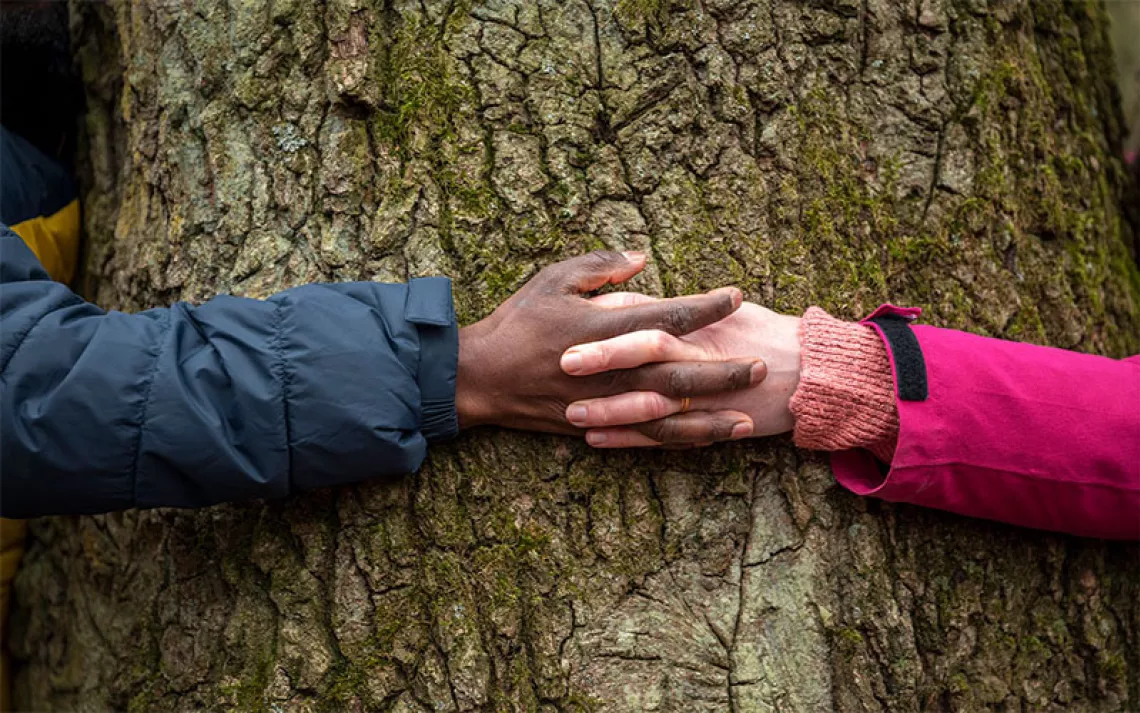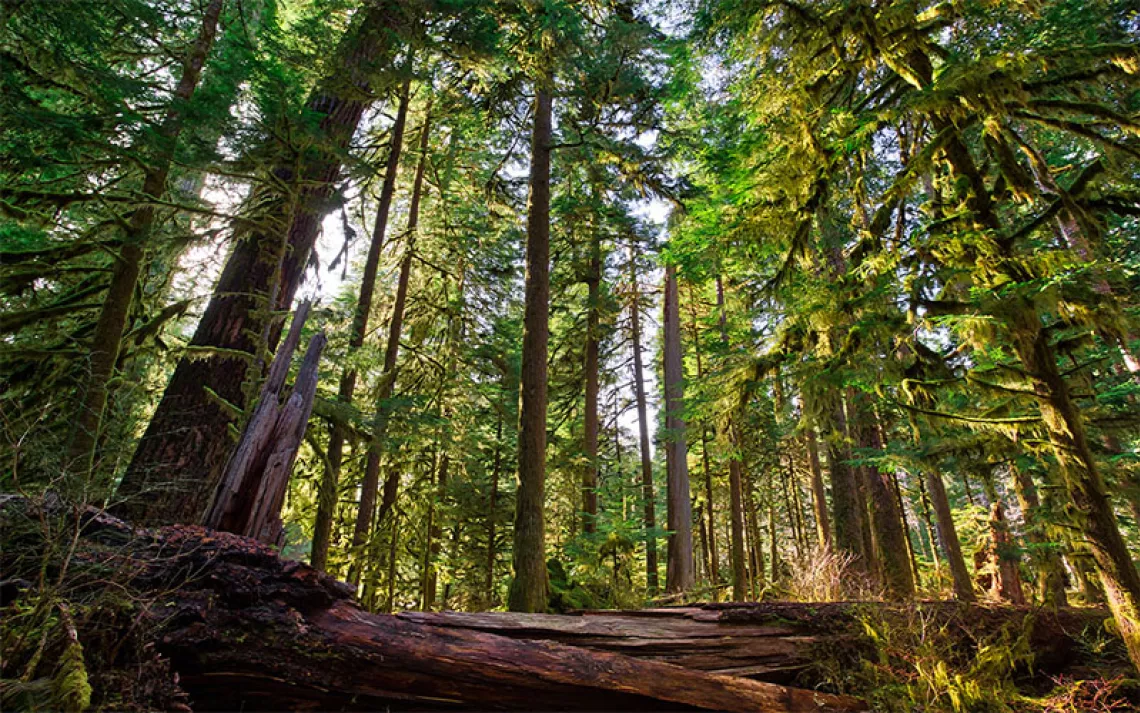The Demise and Potential Revival of the American Chestnut
Before a disastrous blight, the American chestnut was a keystone species in eastern forests. Could genetic engineering help bring it back?
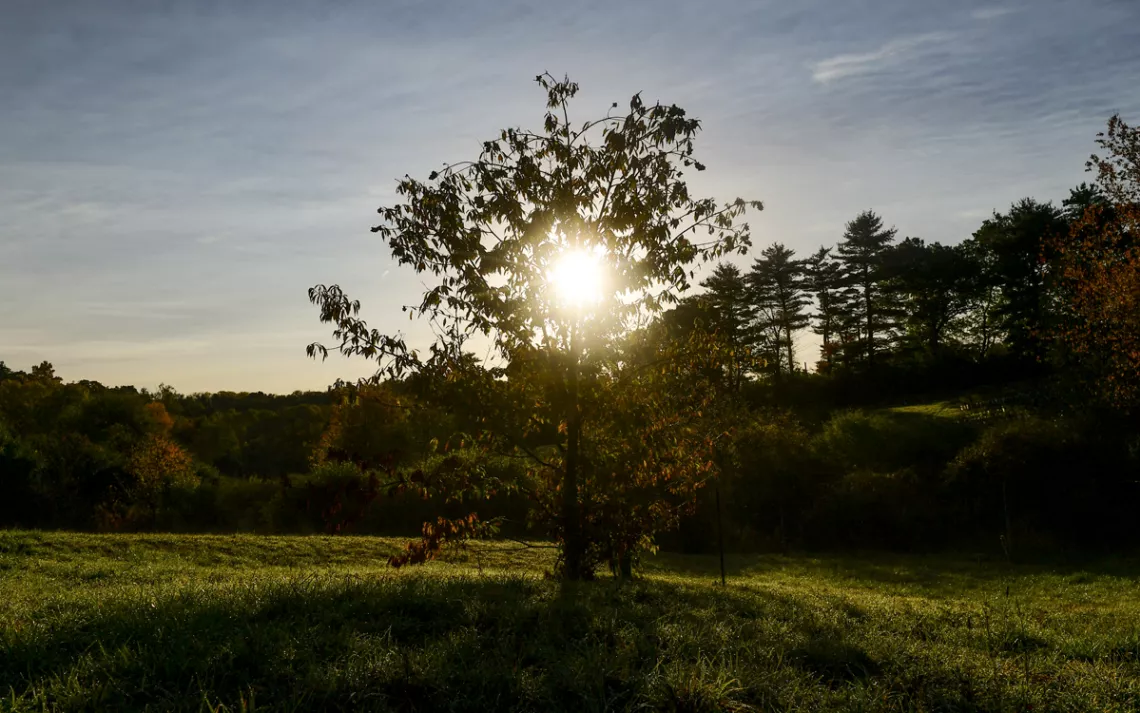
IN CENTRAL PENNSYLVANIA, there are monuments to the dead. Inside century-old barns and farmhouses, ceiling beams and wide floor planks that are straight grained and honey red with age serve as reminders of one of the deadliest epidemics to ever reach American shores. Between 1904 and 1940, some 3.5 billion American chestnut trees, the giants of the Appalachian hardwood forest, succumbed to a fungal blight called Cryphonectria parasitica.
The loss was stunning—not just for sprawling ecosystems across much of the eastern United States, where the tree was a keystone species, but also for the Appalachian way of life. At the dawn of the 20th century, hundreds of millions of chestnut board feet were milled annually, fueling a multibillion-dollar timber industry (as measured in today's dollars). With the trees and their profitable nuts and timber gone, a culture of forest-based subsistence began to fade in the mountains, just as another business started to boom. By 1920, there were 11,000 coal mines working to meet America's growing energy needs. The Appalachian landscape was reshaped twice over: first by the death of the chestnuts, then by a century of coal mining that stripped and scarred the earth, leaving piles of rubble in its wake.
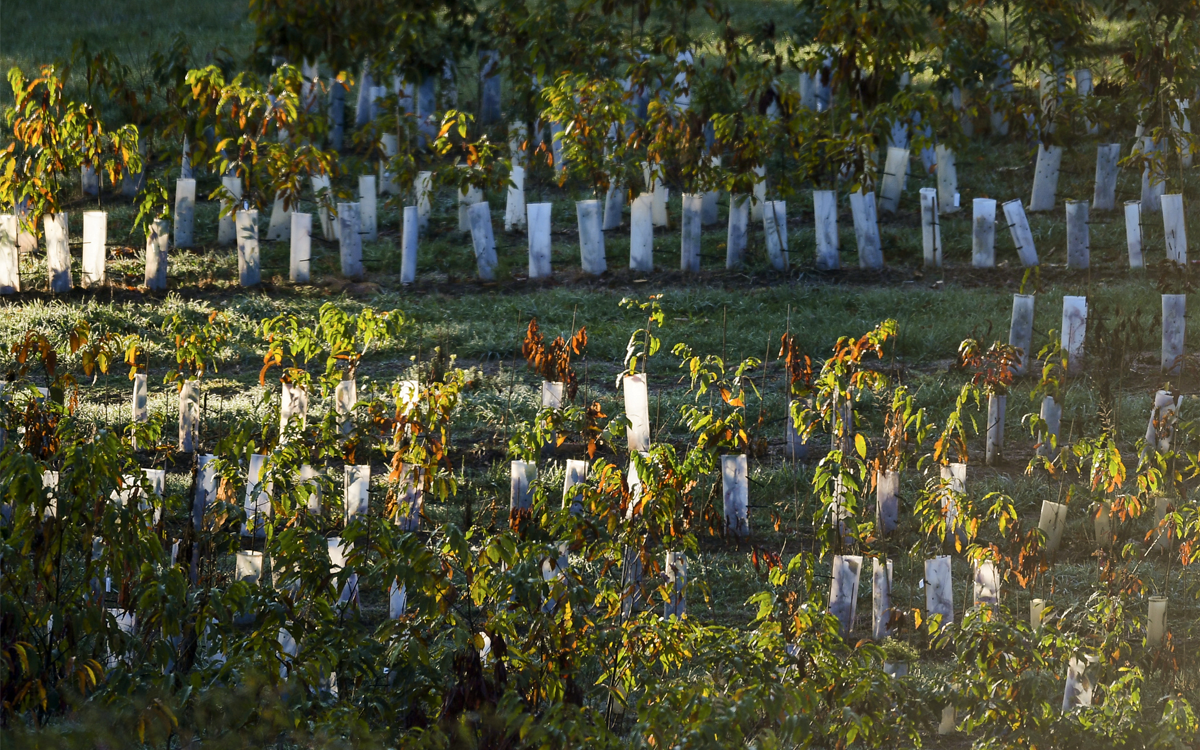
Experimental chestnut trees at a nursery in State College, Pennsylvania.
By almost any metric, the American chestnut was a perfect tree. Massive, fast-growing, and rot-resistant, it was easy to mill into cabin logs, furniture, fence posts, and railroad ties. After being harvested, it resprouted; in 20 years, it was ready for the sawyer again. Wide limbs spanned the canopy, filtering sunlight and creating a diverse, layered forest below. Sweet, acorn-size nuts fed squirrels, deer, raccoons, and bears. Cooper's hawks nested in the high branches, wild turkeys in the lower forks. Insects thrived in the craggy bark, which was naturally tannic and a good choice for preserving hides. Cherokee people made dough from the crushed nuts, treated heart troubles with the leaves, and dressed wounds with astringent brewed from the sprouts. And in the fall, when the chestnuts piled up in carpets half a foot thick, white settler families collected and sold them by the bushel. One railroad station in West Virginia shipped 155,000 pounds of chestnuts to destinations along its northern route.
In a range stretching from southern Maine to the Florida Panhandle and west to the Mississippi River, the chestnut dominated the landscape, accounting for a quarter of all trees in the eastern hardwood forest. In Appalachia, the heart of the tree's native range, generations of people were rocked in chestnut cradles and buried in chestnut caskets.
But the dominance wouldn't last. In 1904, a forester noticed something odd happening to the chestnuts at the Bronx Zoo in New York. The trees were developing cankers surrounded by strange spotty, orange-yellow patches. He called in mycologist William A. Murrill to examine the fungus. By the time Murrill published his findings just over a year later, the disease had spread to New Jersey, Maryland, the District of Columbia, and Virginia.
"My observations in the Bronx this season have led me to take a gloomy view regarding the immediate future of the chestnut here," Murrill wrote, warning his incredulous colleagues that the blight would kill every chestnut tree.
Scientists from the US Department of Agriculture would later determine that the fungus had arrived on ornamental Japanese chestnuts imported as early as 1876. When the blight was discovered at the Bronx Zoo, it was already too late to stop it.
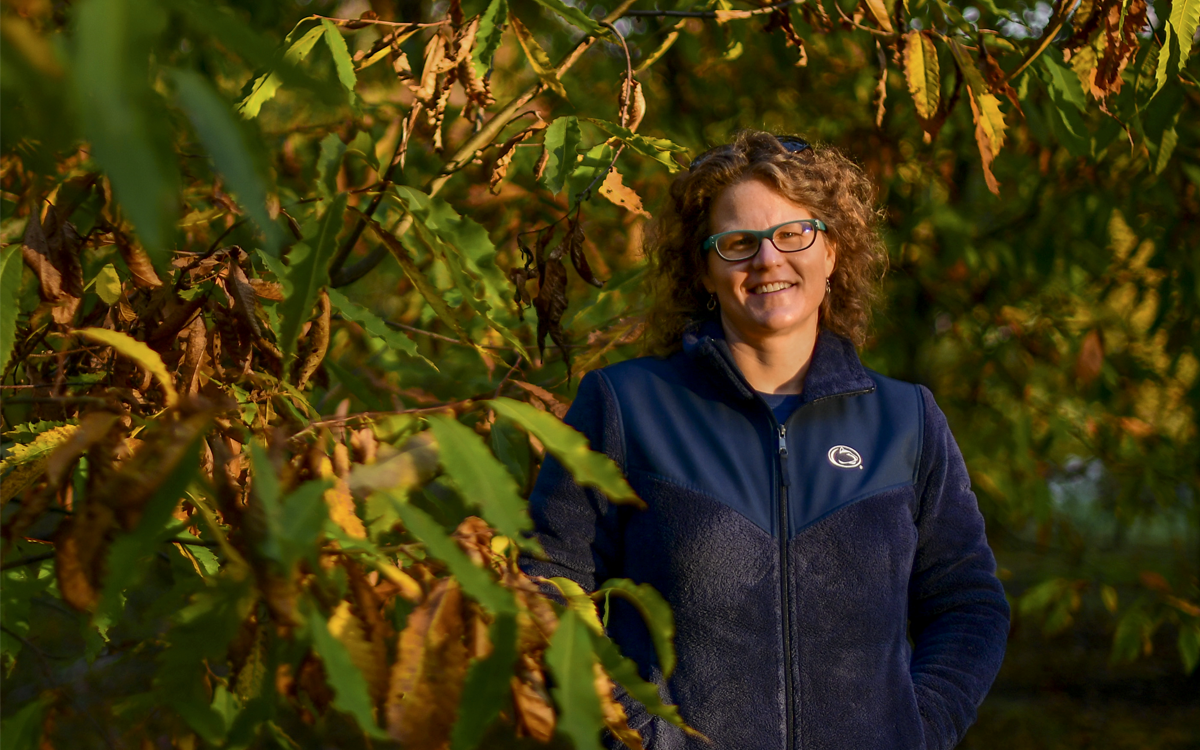
Researcher Sara Fern Fitzsimmons of the American Chestnut Foundation.
SARA FERN FITZSIMMONS is part of a small army of biologists, ecologists, foresters, and activists who are passionately dedicated to bringing back the iconic tree. Shouting over the hum of a greenhouse fan, Fitzsimmons, who is the director of restoration at the research nonprofit the American Chestnut Foundation (TACF), is waving a golden, jagged-edged leaf at me as she explains that the chestnut genus, Castanea, originated in China. The Cryphonectria parasitica blight fungus survives on dead tree tissue, and in the three species of chestnuts in China, it lives mostly unobtrusively, feeding on damaged cambium under the bark where a tree's been wounded by weather, an animal, or insects. These trees, which evolved alongside the blight, grow burl-like callus tissue around the wounds, creating barriers that keep the fungus from spreading.
"People think the Chinese chestnuts are immune to the blight; there's no such thing as immunity," Fitzsimmons says. "But they can wall off the infection really quickly, surround it with that callus tissue, and stop it progressing." Japanese chestnuts have about the same (though slightly less) resistance as the Chinese varieties, she says, and "Europeans have more resistance than the American, which has very little." Once Cryphonectria parasitica colonizes a wound on an American chestnut, it's unstoppable. It polishes off the already-dead tissue, then secretes oxalic acid, a toxin that kills more and more of the chestnut's cells, feeding the fungus but killing the tree.
Carried on the wind, the blight spread an estimated 50 miles a year, tree by tree. First a canker would appear, causing the bark to bulge or sink. Soon the wound would burst open, sending spores sailing outward from an ocher-colored blotch, the tree's inner layers exposed. The mighty upper limbs died first, then the trunk. By 1910, coalitions had been formed and quarantine lines drawn. Boy Scouts were enlisted to scour forests and cut down blighted trees. "Woodman, burn that tree; spare not a single bough," urged a Pennsylvania newspaper. It was no use. By the time the blight had run its course, nearly 4 billion American chestnuts across some 300,000 square miles were gone.
"I was born in 1930, and I only remember dead trees," says Blair Carbaugh, a retired biology professor from Pennsylvania's Lock Haven University and a longtime chestnut-recovery activist. "There were dead stems in the woods here and there. My father and grandfather told me they'd been chestnuts and these were their standing skeletons."
The American chestnut does have one defense mechanism against the blight: While the tree aboveground dies, often what's beneath the soil remains viable. Chestnut roots in Appalachian forests are constantly shooting up new sprouts. They resemble shrubs more than trees—live stems clustered around a dry, dead one, with serrated oval leaves that pop, golden yellow, against the underbrush. There are an estimated 430 million wild American chestnuts still growing in their native range, and while the majority of them are less than an inch in diameter, they're easy to find if you know what you're looking for. But even these persistent saplings are doomed. Most survive only five or 10 years before the blight gets them too.
MEANWHILE, THE COAL INDUSTRY has left its own wake of destruction in the Appalachian forest. In a single scoop, an average-size Bucyrus-Erie dragline can move more than 100 tons of earth. This machine drove the biggest technological shift mining has ever seen, wiping out ecosystems as well as a lot of the underground mining jobs that had rescued the region's economy after the chestnuts died off.
It takes a skeleton crew to run a strip mine, using explosives to blast apart several hundred feet of ground and reveal the coal layers beneath. The dragline lifts away the topsoil and rock and deposits it in nearby valleys, reshaping entire topographies and leaving behind wide swaths of barren, contaminated land. While a raft of federal and state regulations require the cleanup of former mine sites, even the best remediation techniques often fall short of returning the stripped land to anything resembling a natural state.
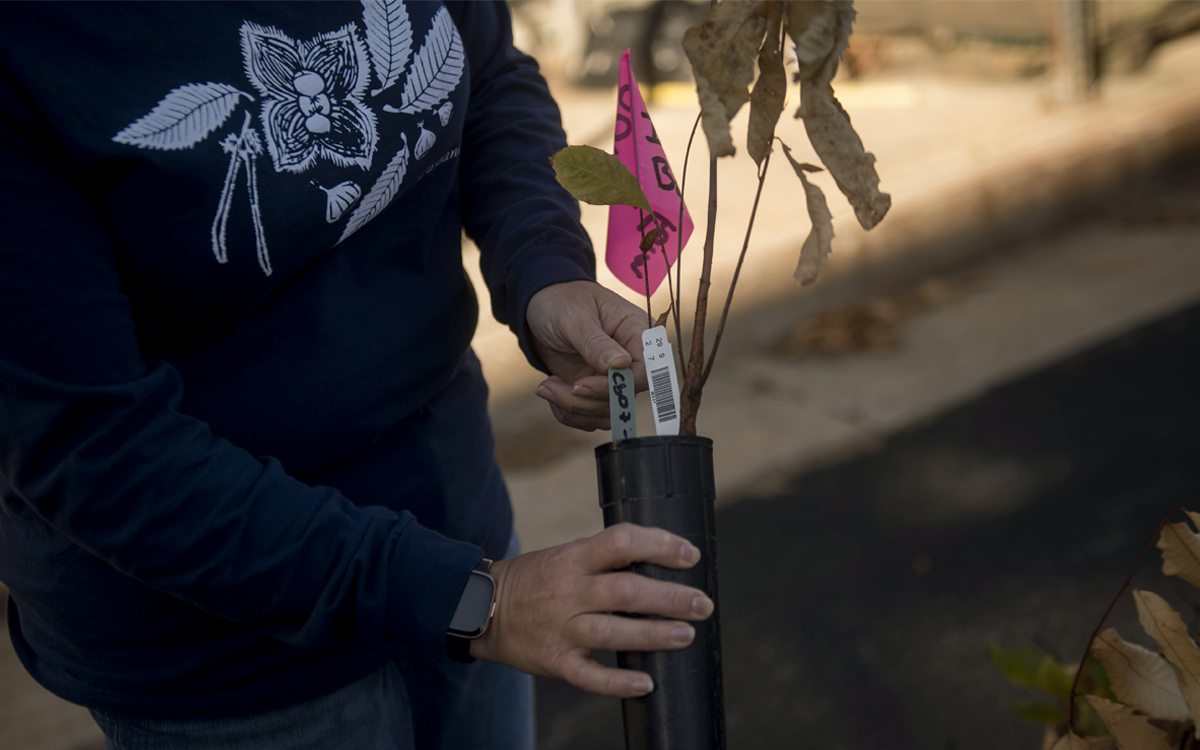
A carefully bred chestnut seedling.
"In the early years, it was 'recontouring,' basically just filling in the holes," Carbaugh says. If the land was forested before it was mined, regulations required it to be reforested. "Trees didn't do well," Carbaugh continues. "The topsoil was gone, and fertility was low. They turned that earth upside down, and when they did the reclaiming, it was just rearranging what was at one time 50 feet underground and trying to get something to grow on it."
Heavy equipment was used to tamp down the ground to stem erosion, and while trees didn't root in the compacted earth, fast-growing, non-native grasses did. "Miners wanted to get out from under this legal obligation," Carbaugh says. "They could say, 'Look, it's grassland!' and the Bureau of Abandoned Mine Reclamation would let them off the hook if it was green."
This twisted version of restoration created meadows where there ought to be forests, explains Michael French, a restoration ecologist and the director of operations for the Kentucky-based nonprofit Green Forests Work. "When you went to plant trees, it was like planting in a gravel parking lot," he says. By some estimates, a million or more acres of Appalachian forest were denuded by the coal companies and then converted, in the name of reclamation, into pasture areas with low or nonexistent biodiversity.
In the early 2000s, a coalition of environmental groups, mining companies, and government agencies launched the Appalachian Regional Reforestation Initiative, which partners with Green Forests Work and other local restoration organizations. "We go in with a large bulldozer and rip up the compacted ground, which allows rainwater to infiltrate the soil," French says. "What we do is like tilling your garden but on a forest scale." A combination of volunteers and paid contractors plant native trees—pine, oak, tulip poplar, locust, and chestnut.
More than a quarter of a million acres have been re-reclaimed in this way. But while the poplars will flower and the oaks will stretch for the sun, from the moment they're planted, the chestnuts' days are numbered.
I'M PICKING MY WAY THROUGH BRAMBLE, trying to keep up with Fitzsimmons as she navigates a stand of young trees, identifying species in a clipped, low alto. The prickly bushes seem to part willingly for this woman in her forties with a mess of dark curls and a loud laugh.
The hillside we're standing on is former mineland in Coal Township, an hour north of Harrisburg, Pennsylvania. Though Fitzsimmons assures me that at one point the trees on the plot we're surveying grew in neat rows, there's nothing neat about them now. The only evidence that this is not a wild place is a tall fence and white plastic tubes around the bottoms of the trees. Fitzsimmons squats to tug at a tube, sweeping dirt and shiny black bits of coal out of the way. In 2014, Fitzsimmons and a team of volunteers with TACF planted hundreds of chestnuts here, driving tubes into the ground to protect the trees as they sprouted. One of the planters was first-time volunteer Liz Schwartz, who remembers saying a little prayer every time she tucked a nut into the hardscrabble.
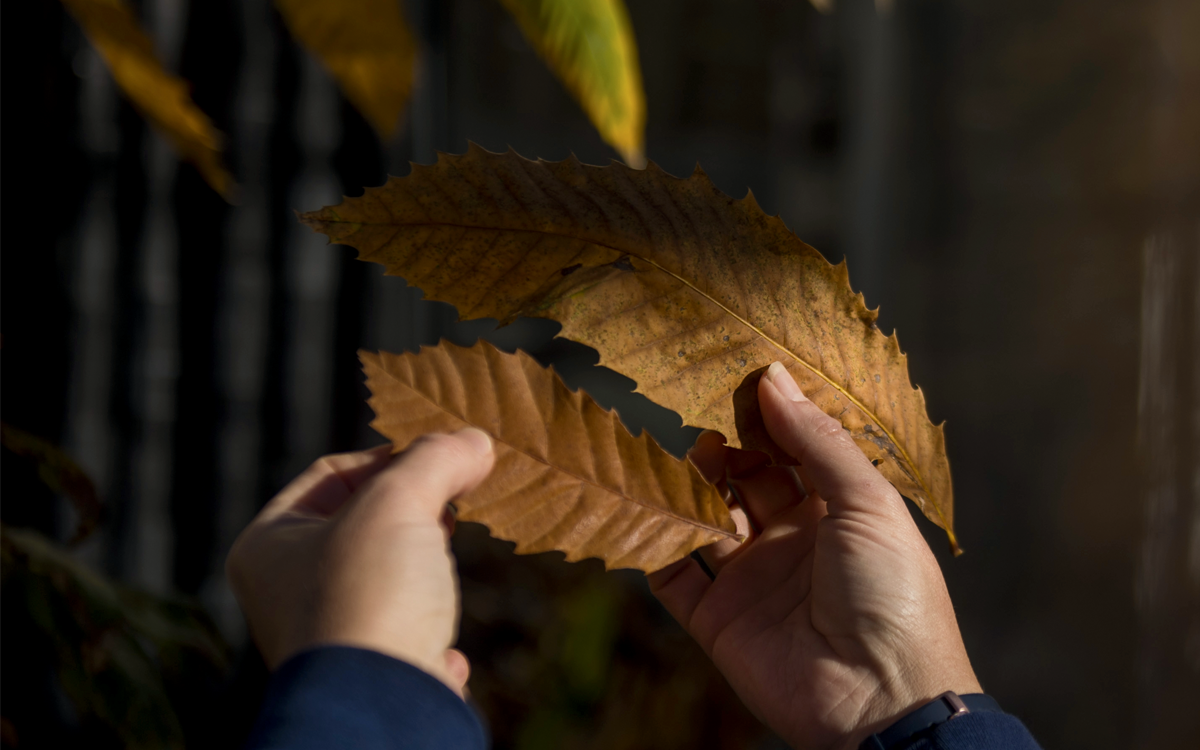
Leaves of a Chinese chestnut.
Six years later, improbably, the chestnuts seem to be thriving, the largest maybe 25 feet tall. Between them, there are yellow poplar, black locust, aspen, sumac, and fire cherry trees, volunteers whose seeds blew in or were dropped by birds or small mammals.
"It's fascinating to see these sites develop," Fitzsimmons says. "This is the 'dog hair stage,' where the growth is as thick as the hair on a dog and you're fighting through brambles. In 10 years, we'll have canopy closure." Starved for sunlight, the low, barbed bushes will die back. Trees will mature, and shrubbery will spread out. Eventually, "it becomes a forest."
This is one of 40 plantings on former mining sites across Pennsylvania's coal region. The reclaimed mines have become unusual nurseries for TACF's breeding program, which has spent more than three decades trying to create blight-resistant trees. Not much thrives in the torn-up, thin, and acidic soil, but chestnuts seem to love it. Superimpose maps of the historic chestnut range and the coalfields and the two overlap almost exactly.
"I find that the chestnuts especially grow pretty well in rocks," Fitzsimmons says. "It's a drainage thing—they really don't like to have wet feet." The open landscape means saplings don't have to compete for sunlight. The acidic ground offers chestnuts the low-pH earth they prefer. And because the topsoil was carried out with the coal, there's no Phytophthora, a dirt-dwelling, root-rot-causing mold that has plagued chestnut test plantings elsewhere.
Most of these trees will eventually succumb to Cryphonectria parasitica. In the meantime, however, the plantings offer an opportunity to observe how trees produced by the breeding program grow and what, if any, blight resistance they may have.
"The mine lands aren't doing anything right now," Fitzsimmons says. "It's a great opportunity to experiment and make them productive in some way. You're certainly not going to make it worse."
IN A PLASTIC-WALLED SHADE HOUSE at Penn State University, Fitzsimmons inspects chestnut sprouts in plastic pots. Some look healthy, with big, saw-toothed leaves. Others are struggling, orange spores beginning to climb their tiny trunks. They are this year's crop of crossbreeds, trees descended from an initial cross of American, Japanese, and Chinese chestnuts. A few months ago, Fitzsimmons and her colleagues punctured their bark, introduced Cryphonectria parasitica spores, and let the fungus go to work. "Every week we come in and cull," she says, "and that's how we measure variable resistance. We got about 40 to 50 percent survival through this particular year."
The breeding program began in 1989 at a research farm in Meadowview, Virginia. The scientists of TACF hypothesized that it would be possible, over generations, to breed a chestnut that had all the characteristics of its native forebears but contained just enough Chinese genes to fend off the blight.
Their method, called backcross breeding, began with creating half-American, half-Chinese chestnut trees. That generation, known as F1, was backcrossed with an American, creating generation B1 F1. The backcross was repeated twice, resulting in B2 F1, then B3 F1. That fourth-generation tree was then bred twice with other backcrosses, leading to generation B3 F2 and, finally, B3 F3—a tree that is essentially 15/16ths American chestnut.
For the trees in Fitzsimmons's Penn State lab, six generations down the line, resistance still isn't guaranteed. Some appear to have no resistance at all. Others put up a fight, attempting to wall off the blight. Over the long term, though, even the B3 F3s have a survival rate of only around 20 percent.
When the backcross program began, Fitzsimmons says, "the thinking was that resistance was a very simply inherited trait, controlled by two or three genes. If that were the case, this would have worked. However, we know now that chestnut blight resistance is more complicated than that."
In the 1990s, William Powell, a professor at SUNY College of Environmental Science and Forestry in Syracuse, New York, who'd been contracted by the state's chapter of TACF to help solve the chestnut puzzle, had what he calls a eureka moment. For years, Powell had been examining ways to insert blight resistance directly into the American chestnut's genome. If resistance was genetically complicated, he posited, a simpler solution would be to add a defense mechanism from elsewhere. Wheat and other cereals produce an enzyme, often shortened to OxO, that protects them "from disease caused by oxalic acid by producing oxalate oxidase," Powell explains. The chestnut blight "all rotates around this acid. If you can get rid of that, all of a sudden it can't get into healthy tissue."
Powell started with embryos from an American chestnut near Binghamton, New York, that hadn't totally succumbed to the blight. He inserted a gene that produces the OxO enzyme and grew seedlings that looked like tiny palm trees on petri dish islands of agar. By introducing the OxO gene to different parts of the genome, he was able to test whether the transgenic tree would produce the blight-fighting enzyme. Gene placements met with varying levels of success. "We did a lot of weeding out," Powell says.
The first petri dish chestnuts were grown in 1995, and progress was steady, if slow. One particular iteration, called the Darling line (after Herb Darling, a conservationist who had supported Powell's work from its earliest days), was especially promising. On July 12, 2012, a colleague of Powell's, Linda McGuigan, inserted the OxO gene into Darling 58—and the resulting tree just might be the one that could save the species.
Genetically speaking, Darling 58 is an entirely American chestnut with one extra gene that gives it a bonus characteristic: resistance to Cryphonectria parasitica.
HERE IS WHERE THINGS GET MESSY. In 1996, while Powell was cracking chestnuts to fish out diminutive embryos, American agrochemical company Monsanto introduced the Roundup Ready soybean, a transgenic plant modified with a bacterium strain that rendered it immune to glyphosate—the active ingredient in Monsanto's Roundup herbicide—followed by several other Roundup Ready crops. In the years since, transgenic plants have faced public resistance in the United States and abroad, and some environmental groups—including the Sierra Club—have opposed the cultivation of genetically modified crops.
But those transgenics have all been commercial ventures. Darling 58's genome has been altered in the name of restoration. There are no plans to establish timber plantations or turn a profit, which ought to make it less objectionable for some. Of course, not everyone is on board: When TACF announced its support of Darling 58, two board members of the Massachusetts and Rhode Island chapter resigned in protest. There are still hard-liners on both sides of the chestnut-restoration community—backcross supporters who think transgenics are dangerous and transgenic supporters who think backcrossing is useless. But once the shortcomings of the backcross breeding program became apparent, the two efforts began working in concert.
"The official position of the American Chestnut Foundation is that we need all methods to do this," Fitzsimmons says. "You're never going to solve such a big problem with one solution."
Since the first Darling 58s matured, her team has been cross-pollinating them with the advanced backcross trees. "At this point, the transgenics are under tight guidelines," she says. "We put bags over pollinated individuals, and then we have to put a steel mesh bag over that to ensure squirrels or other critters don't take the nuts. The USDA permitting guidelines leave no chance, zero risk, of that gene entering the wild and getting out of your control. It's impossible, following these guidelines, for it to escape."
But release into the wild, Powell and Fitzsimmons agree, is the next step on the road to restoration. In early 2020, Powell and his team submitted a nearly 300-page petition to the USDA, requesting that the agency deregulate Darling 58, making it legal for anyone to plant it anywhere. The move would be the first time a genetically modified organism was approved for release into the wild.
After reviewing the application, the USDA opened a public comment period last year. While more than 60 percent were in support of deregulation, there were also plenty of detractors.
The Campaign to Stop GE Trees warned that "the risks of introducing GE [American chestnuts] into forests are numerous and difficult to assess, and regulatory agencies are ill-equipped to evaluate a GE forest tree intended for deliberate spread through wild forests." Carbaugh sees things differently and believes that when it comes to genetic engineering, intention matters. "Making a plant so that it is resistant to Roundup distresses me," he says, "but I'm quite thrilled by what's going on with the chestnut."
For its part, the Sierra Club has counseled caution, but it sees Darling 58 as a low environmental risk, since it would be closely monitored. In a comment on the USDA application, the Club noted that while it still "carries some uncertainties," genetic engineering could, with proper precautions, produce an organism that "provides an environmental benefit."
If Darling 58 is approved for release and its seeds are planted—by members of the public, restoration groups, and anyone else who wants them—their locations will be entered into a TACF database. Then, if all goes according to plan, they'll reproduce, pollinating both wild shoots and backcrossed trees. The result will be genetic diversity and resistance: Of Darling 58's offspring, "half give you the resistance, and half preserve the wild type," Powell says. "In 100 years, a transgenic tree will still be producing wild ones."
And that is, as Fitzsimmons sees it, the only way to give the American chestnut a fighting chance. "People think Darling 58 is a silver bullet, or that the OxO gene is immunity, but it is not." The path to true resistance, she says, requires both the variable Chinese-derived resistance of the backcrosses and the OxO gene expression of the transgenics. "Combining methods gives you a much more robust and resilient population, which has more than one method to fight the fungus."
That gets us a tree that can survive the blight, but it'll need help to thrive on the scale of a forest—which is why the abandoned mines of Pennsylvania have become so important. Healthy chestnuts produce a large amount of seeds, but they don't readily germinate on their own because they are often eaten. That'll be true of the Darling 58 offspring too. "After 100 years, it might travel a mile," Powell says. "It will spread, but it's not a weed."
Turn the coalfields into thriving, mature chestnut forests and the trees could do the rest, seeding themselves into adjacent forestlands. Slowly, from these debased landscapes, a new forest would expand outward. Imagine autumn in a sloping grove, broad, craggy trunks climbing the hillside, their long golden leaves wafting down to catch in the branches of rhododendrons and the needles of evergreens below. Black bears, fat on sweet chestnuts, drag their feet on the loamy ground and salamanders skitter through vernal pools in the forest that was and the forest that could be.
"We call this a century project," Powell says. "To get it to look even somewhat like it did before the blight is going to take centuries. It's for the next generation—it's planting a tree you'll never enjoy the shade of." It requires a kind of optimism unique to those who look at the badland of a strip mine and envision a forest, the kind of faith held by those who plant a seed in desecrated ground and say a prayer.
This article appeared in the March/April edition with the headline "Once Upon a Tree."
This story was funded in part by the Sierra Club’s Beyond Coal campaign.
Correction: The original version of this story inaccurately reported on the type of coal typically extracted in stripmining operations in Appalachia; it's bituminous, not anthracite.
 The Magazine of The Sierra Club
The Magazine of The Sierra Club


